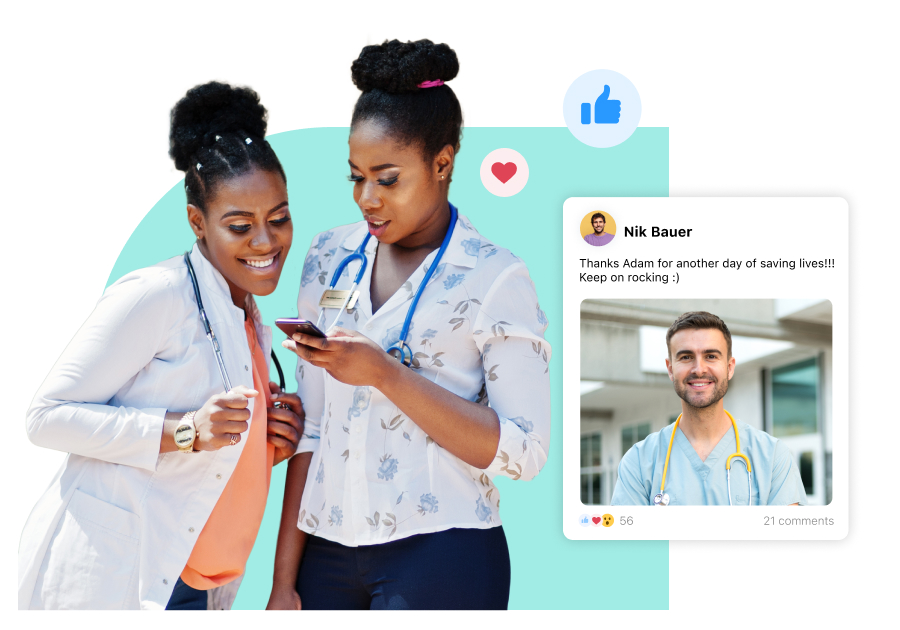Employers use company newsletters to share important announcements, engage workers, and more. In this guide, we discover 9 practical tips for creating an effective newsletter and share some real-life examples to help you get started.
Social isolation and a lack of connection with company missions are leading causes of worker disengagement and mass resignation in the US. This is especially true for distributed teams where workers are scattered across locations.
It’s more important than ever to engage with your workforce and keep them involved in company culture and business decisions. A company newsletter—a digital publication that shares regular, relevant information with workers—is a great way to do this.
In this article, we look at 9 tips for creating a great and engaging employee newsletter. We also provide some real-life examples to help you see what works. Use these as inspiration to craft a winning internal newsletter for your company.
Key Takeaways
- Company newsletters are a great way to connect with workers, keep them up to date, and improve engagement levels.
- Good newsletters are short, simple to read, and easy to understand.
- Companies can use newsletters to share important news, recognize employees, and more.
- You can create and distribute your newsletter through email or opt for modern-day updates with employee management software that has a social feed. You can read our review of the best employee management apps
Keep It Short, Punchy, and Write for Skimming
McKinsey shows that the average worker spends 28% of their day reading and answering emails. With email traffic this high, it’s easy for workers to ignore an employee newsletter, or even miss it altogether. You need to find a way to catch and keep their attention.
Use punchy and appealing subject lines for your internal company newsletter. You could add an exciting part of your newsletter to the subject line. For example, “New unlimited leave policy and more! Read now.” Mentioning something that will intrigue workers is a great way to capture their attention.
Once they’re in, ensure that they engage with all the important points you want to share. Keep the newsletter short so it’s not overwhelming. Also, break it down into bite-sized sections with descriptive headings. This makes it easier for skim readers to find the information they want. You can also add a key takeaways section at the top to share significant updates in one place.
Use Simple Language, Tailored to Your Audience
Today’s workforce is largely made up of Millennials and Gen Z workers—also known as Zoomers. According to Forbes, these workers want content that gets to the point, is relevant to them, and aligns with their values.
The rule of thumb is to keep the writing simple and concise. This way, you’re not overloading the reader with unnecessary information.
Also, avoid using complex or technical words that can confuse your workers. Explain information clearly and include what is happening, why, and how it impacts them. Ambiguous information can be frustrating and misleading.
Cut out redundant words that make your sentences longer without adding value. Changing “period of 4 days” to “4 days” is a good example of this.
Keep the tone informal and conversational as this is easier to read than formal tones. Using pronouns such as “I,” “we,” and “you” is a great way to do this. Moreover, it helps employees feel that the content is tailored and relevant to them.
Lastly, use emojis where appropriate to keep the tone casual and fun. But be careful with which emojis you use in email newsletters and other internal communications. A recent survey found that 74% of respondents misunderstood emojis at some point. For example, some people use the crying emoji to express tears of joy, while others use it to express that they’re upset.
Make It Informative
An internal newsletter gives you a single place to share important information with your team members. Here are some ways that you can make the most of this communications channel.
- Make company-wide announcements. For example, the implementation of a new company policy, retirement news, or welcoming new joiners.
- Keep employees up to date with industry trends, new regulations, and other relevant news.
- Remind them of upcoming events like webinars, team offsites, and so on.
- Remind them of upcoming deadlines, such as open enrollment for company benefits or signing up for a volunteering day.
- Provide leadership updates. This could include a change in the company’s strategic direction, this year’s promotion list, and more.
- Share FAQs to answer the most common employee queries. This will save you time from having to deal with them individually.
Make It Interactive and Get the Team Involved
It’s futile to provide important information if no one is going to read it. Keeping employees engaged with your internal company newsletter is important. You can do this in the following ways.
Use multimedia
Embed videos to keep workers visually engaged with the content. They tell a story and are a great way to provide workers with information without asking them to read through long paragraphs or sentences.
Although they can be less impactful than videos, images help provide visual breaks and add an element of fun to your newsletter.
Finally, GIFs—which are animated images—are also an effective way to attract attention.
Use polls or announce the results of previous surveys and polls
Embedding short surveys or polls into your newsletter is an effective way to keep employees engaged. Plus, you gather important feedback that you can use to drive cultural decisions.
You can also share results from previous surveys and polls. Workers who participated will be interested in knowing the results. They’re more likely to open and read newsletters that share at least part of these insights.
Have employees contribute to the newsletter
Many fun company newsletter ideas come from employees themselves. Ask workers what they want to see in the newsletter. This is a powerful way to ensure that they’re connecting with the content.
Also, consider having some sections written by employees themselves. For example, an employee could write a case study about a particular project and the lessons from it. Or, you could have a team spotlight where a worker can share more about their personal life—e.g., their recent wedding. Elements like these help create a sense of belonging and community at work.
Share an internal job board
Among engaging company newsletter ideas, sharing open roles is one of the best ways of keeping workers engaged. Today, workers want more opportunities for growth and internal mobility. They’re likely to open every edition of your newsletter if it helps them find their next opportunity within the company.
Have an “Ask Me Anything” (AMA) section
Give employees a platform to ask any questions they have about the company culture, working practices, and more. Most companies anonymize the AMA section to encourage employees to be open with their questions. This helps establish a culture of trust between workers and management.
Include a virtual suggestions box
Provide workers with a place to share their feedback and suggestions—and give them the option to do this anonymously. Not only does this allow workers to interact with the newsletter but it allows them to also feel heard and valued by the company.
Include call-to-actions (CTAs) throughout the newsletter
To ensure that workers are engaging and interacting with your content, include CTAs in as many sections as possible. A CTA tells workers exactly what you want them to do next. For example, share a link to your latest social media post and ask workers to “like, subscribe, or share” the post with their networks.
Use Technology for Building, Distributing, and Tracking Newsletters
Company newsletters don’t have to follow the boring old format of a classic email in your inbox. Nowadays, there are plenty of modern apps available that let you creat engaging and fun newsletters,
Connecteam is an all-in-one employee management app that makes it easy to distribute engaging newsletters to your frontline team. With its intuitive design and user-friendly interface, Connecteam allows you to create and send custom newsletters directly to your employees’ smartphones and reach them no matter where they are.

One of the best things about using Connecteam to distribute newsletters is that you can create engaging and interactive content that will keep your employees interested and motivated. You can include videos, images, and interactive elements such as quizzes and surveys to make your newsletters more engaging and informative.
Another great feature of Connecteam is that it allows you to track your newsletter’s performance in real-time. You can see who has opened your newsletter, which articles are most popular, and how many clicks your links are getting. This data can help you make informed decisions about future newsletters and improve your communication with your team.
Get started with Connecteam for free today and distribute fun and engaging updates to your entire staff.
📚This Might Interest You:
Keep your team informed and engaged! Explore our guide to the best internal newsletter software to easily create and share updates, announcements, and company news. Streamline communication and boost team engagement today!
Focus on Increasing Overall Employee Engagement Levels
Great employee communications tools can help improve engagement at work. Here are some examples of the benefits of effective newsletter content.
Reinforce company purpose and values
The current generation of employees wants to work for employers whose purpose and values align with their own. Gallup found that 67% of Millennials are more engaged at work when they can relate to their company’s mission.
You can use your employee newsletter to remind workers of the organization’s mission and how they contribute to it. For example, share company wins and milestones with workers so they can see how their hard work is paying off. Or, add positive customer stories and testimonials so they’re motivated to keep up the good work.
Offer training and development opportunities
The University of Phoenix found that over 65% of workers would stay with their employer if their company made an effort to upskill or reskill them. Keep workers informed about the latest training and development opportunities through the newsletter. This includes upcoming courses, skills development days, mentorship programs, and so on.
Recognize and celebrate employees
Drive a culture of excellence by publicly recognizing workers’ achievements in the newsletter. You can also announce winners of awards such as employee-of-the-month. This helps employees feel appreciated and also motivates others to follow suit.
Further, you can celebrate milestones such as birthdays and work anniversaries for everyone. This is a great way to make workers feel valued and boost overall morale.
Discuss company initiatives and activities
The newsletter is a good place to keep employees informed about all company activities and initiatives. For example, tell workers about any upcoming internal competitions and how they can sign up for them. You can also inform them about initiatives like mental health days, Diversity, Equity, and Inclusion (DEI) events, and more.
Design It Well
The best newsletter designs are easy on the eyes and provide a great user experience. Here are some tips to create a simple, user-friendly interface.
- Stick to a clean and simple layout with clear headings and sections.
- Include high-quality visuals and graphics to break up the text and make it engaging.
- Use a readable font and font size so content is easy to process. Don’t use more than 2 font styles to avoid visual confusion.
- Optimize it for mobile viewing. Millennials and Zoomers will likely read the newsletter on their smartphones.
- Ensure your CTAs are clear, visible, and stand out so that workers don’t miss them and know what they’re required to do.
Test It Before and After Distribution
Ensure that you check your newsletter for spelling and grammar before sending it out. You could also do a pilot run by asking a few workers to read it and provide any feedback and suggestions.
Although there’s plenty of guidance, there’s no magic formula for the best newsletter content and design. Tweak your newsletters now and then to see what’s capturing workers’ interest and attention. This is called “testing.” You can test colors, fonts, copy length, and more. For example, you may find workers engaging more when the background color is neutral instead of too vibrant.
Be Consistent
When it comes to testing, change only one element at a time. Try to keep the format as consistent as possible so your employees know how the newsletter is laid out and what information to find where.
In addition to a consistent format, you must also be consistent with publishing. Distribute your newsletter at regular intervals—e.g., weekly, monthly or quarterly. This way, workers know when to expect it and can look forward to receiving it.
Summary
Employee newsletters help to connect with workers, keep them informed, and ensure they’re engaged. But creating and distributing an effective newsletter is no easy task. You need to make it easy to skim through and engage with. Understanding what content is relevant to your workers and tailoring your newsletter accordingly is also crucial.
A good newsletter will capture and keep workers’ attention. But a great one will also improve actual employee engagement levels. With our top tips and examples, you’re ready to build a great employee newsletter and stay connected with your workforce wherever they are.




